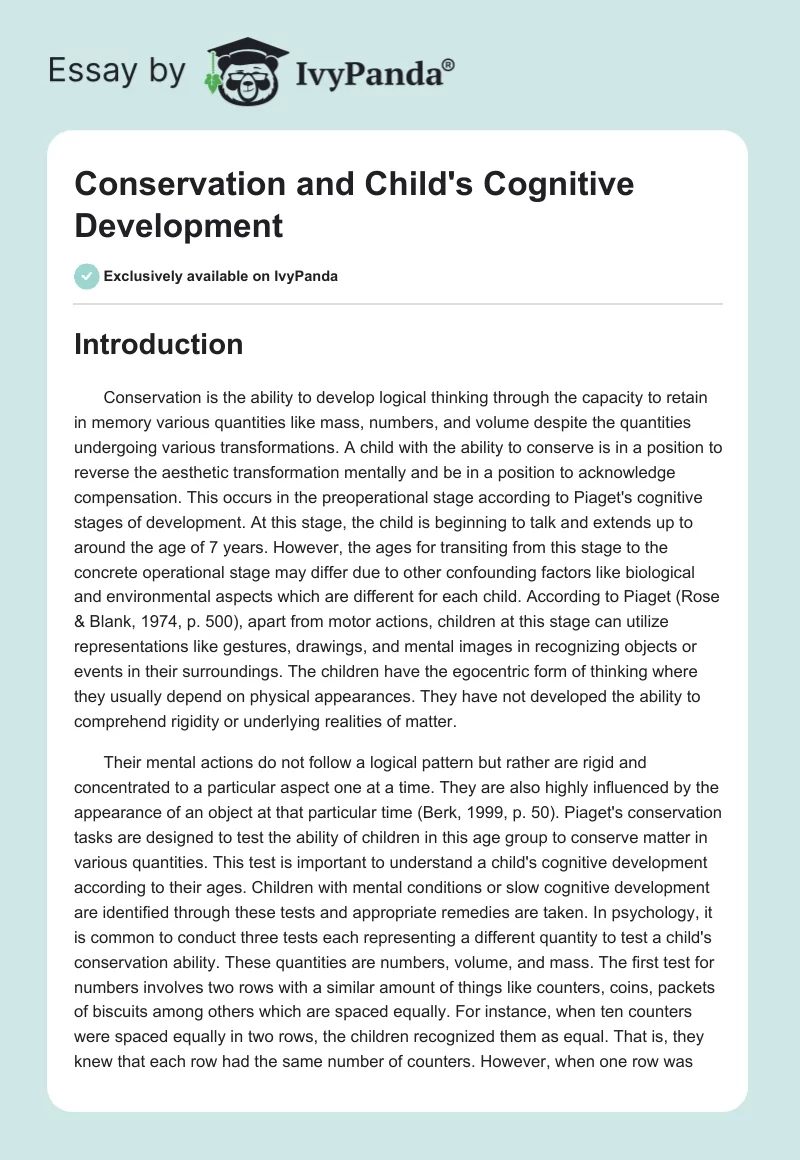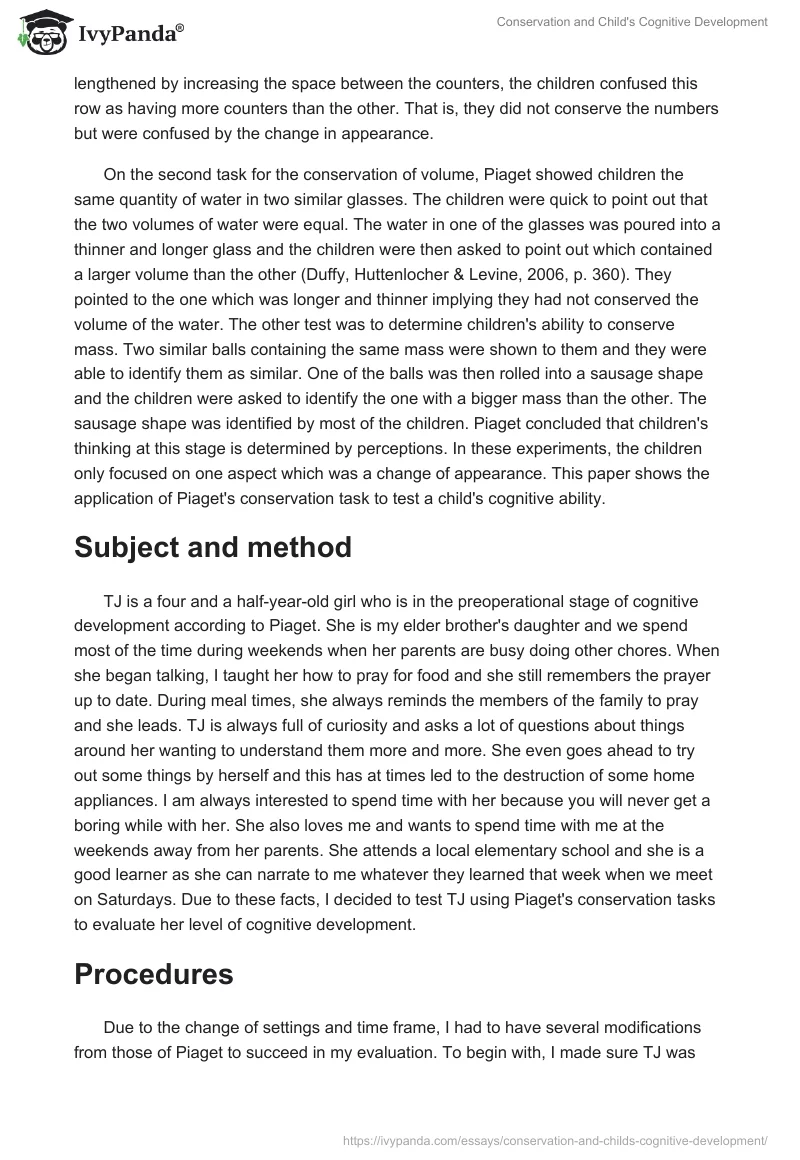Introduction
Conservation is the ability to develop logical thinking through the capacity to retain in memory various quantities like mass, numbers, and volume despite the quantities undergoing various transformations. A child with the ability to conserve is in a position to reverse the aesthetic transformation mentally and be in a position to acknowledge compensation. This occurs in the preoperational stage according to Piaget’s cognitive stages of development.
At this stage, the child is beginning to talk and extends up to around the age of 7 years. However, the ages for transiting from this stage to the concrete operational stage may differ due to other confounding factors like biological and environmental aspects which are different for each child.
According to Piaget (Rose & Blank, 1974, p. 500), apart from motor actions, children at this stage can utilize representations like gestures, drawings, and mental images in recognizing objects or events in their surroundings. The children have the egocentric form of thinking where they usually depend on physical appearances. They have not developed the ability to comprehend rigidity or underlying realities of matter.
Their mental actions do not follow a logical pattern but rather are rigid and concentrated to a particular aspect one at a time. They are also highly influenced by the appearance of an object at that particular time (Berk, 1999, p. 50). Piaget’s conservation tasks are designed to test the ability of children in this age group to conserve matter in various quantities. This test is important to understand a child’s cognitive development according to their age. Children with mental conditions or slow cognitive development are identified through these tests and appropriate remedies are taken.
In psychology, it is common to conduct three tests each representing a different quantity to test a child’s conservation ability. These quantities are numbers, volume, and mass. The first test for numbers involves two rows with a similar amount of things like counters, coins, packets of biscuits among others which are spaced equally. For instance, when ten counters were spaced equally in two rows, the children recognized them as equal. That is, they knew that each row had the same number of counters. However, when one row was lengthened by increasing the space between the counters, the children confused this row as having more counters than the other. That is, they did not conserve the numbers but were confused by the change in appearance.
On the second task for the conservation of volume, Piaget showed children the same quantity of water in two similar glasses. The children were quick to point out that the two volumes of water were equal. The water in one of the glasses was poured into a thinner and longer glass and the children were then asked to point out which contained a larger volume than the other (Duffy, Huttenlocher & Levine, 2006, p. 360). They pointed to the one which was longer and thinner implying they had not conserved the volume of the water. The other test was to determine children’s ability to conserve mass.
Two similar balls containing the same mass were shown to them and they were able to identify them as similar. One of the balls was then rolled into a sausage shape and the children were asked to identify the one with a bigger mass than the other. The sausage shape was identified by most of the children. Piaget concluded that children’s thinking at this stage is determined by perceptions. In these experiments, the children only focused on one aspect which was a change of appearance. This paper shows the application of Piaget’s conservation task to test a child’s cognitive ability.
Subject and Method
TJ is a four-and-a-half-year-old girl who is in the preoperational stage of cognitive development according to Piaget. She is my elder brother’s daughter and we spend most of the time during weekends when her parents are busy doing other chores. When she began talking, I taught her how to pray for food and she still remembers the prayer up to date. During meal times, she always reminds the members of the family to pray and she leads. TJ is always full of curiosity and asks a lot of questions about things around her wanting to understand them more and more. She even goes ahead to try out some things by herself and this has at times led to the destruction of some home appliances. I am always interested to spend time with her because you will never get a boring while with her. She also loves me and wants to spend time with me at the weekends away from her parents. She attends a local elementary school and she is a good learner as she can narrate to me whatever they learned that week when we meet on Saturdays. Due to these facts, I decided to test TJ using Piaget’s conservation tasks to evaluate her level of cognitive development.
Procedures
Due to the change of settings and time frame, I had to have several modifications from those of Piaget to succeed in my evaluation. To begin with, I made sure TJ was aware of the happening in each of the steps, unlike Piaget who did not know if the attention of the child was concentrated on his directions on the tasks or somewhere else (Berk, 1999, p. 34). Efforts were made to ensure TJ had a great interest in the tasks I was subjecting her to. To do this, I used presents which TJ would like and which would belong to her after the tasks are completed. Also, I had TJ go through these tasks with me following everything that I was doing. I decided to first put TJ in tests similar to those of Piaget before the modified ones to see if there will be appreciative differences.
I set two rows of counters each containing 8 counters and questioned her. She noted that they had similar numbers. I then increased the spaces between each counter in the first row. During this time her mind was wandering off and she had less concentration. She noted the first row had many counters and thus did not conserve numbers. According to Piaget, TJ was misled by the perceptual appearance of the first row and thus concluding it contained more bars of chocolate than the other (Flavell, Miller, 1993). On conservation of volume, the same volume of water was put in similar glasses and I asked her which had more. She responded they had a similar volume. The water in the first glass was then poured into a thinner and longer glass of which she noted had greater volume.
Results
On the first task on the conservation of numbers, I set two rows each with 10 bars of chocolate. I had TJ count with me up to ten in each row. TJ was able to appreciate that the two rows which were of equal lengths contained an equal number of bars of chocolate. I put another set of two rows again each containing 10 bars of chocolate. On the first row, I increased the space between the chocolates in the row and thus increased the length of the row. I instructed TJ to do the same to one of the rows of her bars of chocolate. During these moves, much attention was paid and I could observe that her mind was concentrated on the events that were taking place. On questioning her which row contained more bars than the other she noted that they had the same numbers. On conservation of volume, I made TJ help me in mixing up the juice to the best of her flavor.
I then took two similar glasses and TJ helped me to measure equal volume in each glass. After this, I questioned her on which had a larger volume of juice than the other. She noted they had a similar amount. I then asked her to help me fill another taller and thinner glass with the juice from the first glass. After this, I asked her to pick the glass which she thought had a large volume so that she could drink. After a long hesitation, she picked the thinner and taller glass. On asking her why she stated it had more juice than the other. On conservation of mass, I took two balls of malleable matter which were similar in size and of the same material. We started by playing with them by forming various shapes of animals and other things like a bicycle. After some time, I took the two and rolled them back into two similar balls. I asked TJ which ball was bigger than the other upon which she responded that they were similar. With her fully observing, I rolled the first ball into a sausage shape which was longer than the second ball. Again, I asked her which ball she thought had a larger mass than the other. She responded with the sausage shape.
Conclusion
In conclusion, Piaget’s conservation tasks are important in determining the cognitive development of a child in the preoperational stage of development. They provide a chance for a child to be assessed on how well they can keep in memory different quantities despite various aesthetical transformations. The children in this age have not developed the ability to comprehend the changes in their minds and their thinking and assessment is interrupted by a transformation (Duffy, Huttenlocher & Levine, 2006, p. 357). However, as seen in TJ’s case, modifications of Piaget’s conservation tasks to fit the child’s setting can alter the results. On the first test, TJ was able to conserve numbers through increased participation and engagement in the tasks rather than just being instructed on what to do. It is also important to point out that other factors like biological and environmental settings can have confounding effects on the results achieved through the conservation tasks.
Reference List
Berk, L. (1999). Infants and Children. (3rd ed.). Needham Heights, MA: Allyn & Bacon.
Duffy, S., Huttenlocher, J., & Levine, S. (2006). Piagetian Frameworks for Understanding Spatial Development. Journal of Cognitive Studies, Vol. 45, pp. 355-378.
Flavell, J., Miller, P. & Miller, S. (1993). Cognitive Development. (3rd ed.) Englewood Cliffs, NJ: Prentice-Hall.
Rose, S. & Blank, M. (1974). The Potency of Context in Children’s Cognition: An Illustration Through Conservation. Child Development, Vol. 45(2), pp. 499-502.


